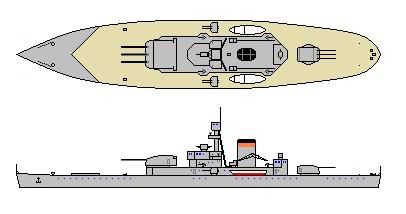[SIZE=3]Bindusara Class Monitor[/SIZE]
The monitor Chandragupta did not return to Asir following her unfortunate engagement with PRS Panay. She deployed instead to the Andaman islands, to assist in their defence, where she would find more safety amongst the many islands, and her heavy battery would be of more use.
The army wasn't too keen on this, feeling it desirable to have heavy naval gunfire capability off Asir in case of a need for fire support or road interdiction missions against the Saudis or Yemenis. The smallest gun they wanted was a 21 cm gun, but the navy refused to station a heavy cruiser at As Salif.
The two services argued for over a year until a 21 cm turret was discovered in storage in a warehouse at the Imperial Ordnance Works in Pondicherry. This turret had been a prototype of the 21 cm guns used in the Hyderabad class cruisers, and would be usable with a bit of work. Sensing a cheap solution to be at hand, the Navy designed a small monitor around this gun and presented the design to the Army. The Army grudgingly agreed that this would be adequate, provided that the 10.5 cm gun was also a low-angle gun for possible fire support use. The Navy conceded the point, reckoning that there was no real Saudi or Yemeni air threat (and that a single 10.5 cm mount would not accomplish much against a determined British, Italian, or French air attack if
that were to come about).
Thus the monitor Bindusara is laid down in Q4, 1931.
Note: The miscellaneous weight allowance is to account for the raised 21 cm turret, springstyle not being keen to let me have it superfiring.

B, laid down 1931
Length, 55.0 m x Beam, 14.5 m x Depth, 2.2 m
1150 tonnes normal displacement (1068 tonnes
standard)
Main battery: 1 x 21.0-cm (1 x 1)
Secondary battery: 2 x 10.5-cm
AA battery: 6 x 3.5-cm
Weight of broadside: 165 kg
Main belt, 3.0 cm; ends unarmored
Armor deck, average 4.0 cm
Conning tower, 3.0 cm
Battery armor:
Main, 10.0 cm / secondary, 3.0 cm shields
AA, 2.0 cm shields
Maximum speed for 800 shaft kw = 12.53 knots
Approximate cruising radius, 3000 nm / 12 knots
Typical complement: 99-128
Estimated cost, $1.365 million
(£341,000)
Remarks:
Ship has slow, easy roll; a good, steady gun platform.
Excellent seaboat; comfortable and able to fight her
guns
in the heaviest weather.
Magazines and engineering spaces are roomy, with
superior
watertight subdivision.
Ship is roomy, with superior accommodation and working
space.
Distribution of weights:
Percent
normal
displacement:
Armament ......................... 45 tonnes
= 4 pct
Armor, total ..................... 301 tonnes
= 26 pct
Belt 54 tonnes
= 5 pct
Deck 187 tonnes
= 16 pct
C.T. 3 tonnes
= 0 pct
Armament 57 tonnes
= 5 pct
Machinery ........................ 32 tonnes
= 3 pct
Hull and fittings; equipment ..... 596 tonnes
= 52 pct
Fuel, ammunition, stores ......... 136 tonnes
= 12 pct
Miscellaneous weights ............ 40 tonnes
= 3 pct
-----
1150 tonnes
= 100 pct
Estimated metacentric height, 0.8 m
Displacement summary:
Light ship: 1015 tonnes
Standard displacement: 1068 tonnes
Normal service: 1150 tonnes
Full load: 1212 tonnes
Loading submergence 602 tonnes/metre
+++++++++++++++++++++++++
Estimated overall survivability and seakeeping
ability:
Relative margin of stability: 1.25
Shellfire needed to sink: 2040 kg = 15.9 x
21.0-cm shells
(Approximates weight of penetrating
shell hits needed to sink ship,
not counting critical hits)
Torpedoes needed to sink: 2.1
(Approximates number of 'typical'
torpedo hits needed to sink ship)
Relative steadiness as gun platform, 93 percent
(50 percent is 'average')
Relative rocking effect from firing to beam, 0.30
Relative quality as a seaboat: 1.86
+++++++++++++++++++++++++
Hull form characteristics:
Block coefficient: 0.65
Sharpness coefficient: 0.52
Hull speed coefficient 'M' = 5.26
'Natural speed' for length = 13.4 knots
Power going to wave formation
at top speed: 50 percent
Estimated hull characteristics and strength:
Relative underwater volume absorbed by
magazines and engineering spaces: 44 percent
Relative accommodation and working space: 163
percent
Displacement factor: 148 percent
(Displacement relative to loading factors)
Relative cross-sectional hull strength: 0.88
(Structure weight per square
metre of hull surface: 345 kg)
Relative longitudinal hull strength: 5.27
(for 4.00 m average freeboard;
freeboard adjustment +1.00 m)
Relative composite hull strength: 1.06
+++++++++++++++++++++++++
[Machine-readable parameters: Spring Style v. 1.2.1]
180.40 x 47.56 x 7.22; 13.12 -- Dimensions
0.65 -- Block coefficient
1931 -- Year laid down
12.53 / 3000 / 12.00; Oil-fired turbine or equivalent --
Speed / radius / cruise
40 tons -- Miscellaneous weights
++++++++++
1 x 8.27; 1 -- Main battery; turrets
Central positioning of guns
:
2 x 4.13; 0 -- Secondary battery; turrets
Gun-shields
:
8 x 1.38 -- Tertiary (QF/AA) battery
Gun-shields
:
0 -- No fourth (light) battery
0 -- No torpedo armament
++++++++++
1.18 / 0.00 / 0.00 / 0.00; 100 -- Belt armor; relative
extent
1.57 / 1.18 -- Deck / CT
3.94 / 1.18 / 0.79 / 0.00 -- Battery armor
(Note: For portability, values are stored in
Anglo-American units)
+++++++++++++++++++++++++++++++++++++++++++++++++++++++


